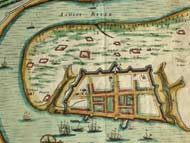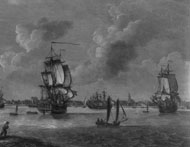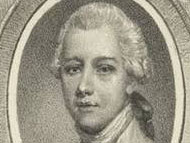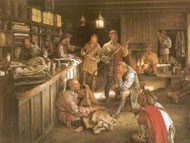The Founding of Carolina
In 1660, after nine years in exile during the English Civil War, King Charles II was restored to the British throne. Eight powerful noblemen who had supported his return petitioned the Crown for a charter to Carolina. In 1663, King Charles II granted the Carolina Colony to Edward, Earl of Clarendon; George, Duke of Albemarle; William, Earl of Craven; John Lord Berkeley; Sir John Colleton; Anthony Lord Ashley; Sir George Carteret; and Sir William Berkeley, and declared them “true and absolute lords and proprietors” of the province. The Carolina Colony stretched from the Atlantic to the Pacific and included most of the Southeast.
The eight Lords Proprietors were to encourage settlement and to govern the new colony. Many people were happy to come to Carolina from England, the West Indies, and particularly from the overcrowded English colony of Barbados. In 1670 a group of approximately 130 English men and women settled at Albemarle Point on the west bank of the Ashley River. Enslaved Africans, as well as white indentured servants came to Carolina with their masters. The first few years of the colony were difficult. The settlers relied on supplies from England as they worked hard to build a fortified settlement, grow provisions, and find products that were easy to produce and sell for profit.
In 1680, the settlers moved their town down the river to Oyster Point, the present location of Charleston, and named it Charles Town. The new settlement was laid out along wide straight streets. Around 1690, residents constructed a wall around the new town to protect it from the French, Spanish, and hostile Native Americans. The walls enclosed approximately 60 acres and roughly extended from the intersection of East Bay Street and North Battery along East Bay Street to Market Street, from Market Street to Meeting Street, and back along Meeting Street to North Battery. A portion of the old wall can be seen at the Old Exchange Building in downtown Charleston.
Charles Town grew rapidly. By 1700, it was home to approximately 7,000 people, black and white. By the 1730s, interior portions of the city wall were torn down to accommodate the ever-growing population. Between 1729 and 1739 the town doubled from 80 acres to 160 acres. Eight wharves were located along East Bay Street.
At the same time that Charles Town was being established, enterprising businessmen such as Arthur Middleton, Thomas Barker, Ralph Izard, and Joseph Child acquired grants for lands along both sides of Goose Creek and along the Ashley River. They would become some of the colony’s earliest rice planters.
The first Colonial businesses were centered on cattle ranching, the deer skin trade, naval stores, and rice production. Successful businesses thrived by selling provisions such as corn, peas, beef, pork, and lumber to the West Indies. Thousands of deerskins were shipped to England to feed their unquenchable leather industry. English-made consumer goods, West African slaves, wine, sugar, molasses, and rum were the primary commodities entering the Carolina Colony. By 1700, rice was taking hold as the colony’s most important agricultural commodity. By the middle of the 18th century vast fortunes had been created through agriculture and trade. Merchants became planters and planters became controllers of ready capital and credit. By 1750, nine of the ten richest men in British North America lived in the Carolina Lowcountry.

King Charles the II of England, Scotland, and Ireland

Lords Proprietor Lord Anthony Ashley

The inset, A Plan of the Town and Harbor of Charles-Town on Edward Crisp’s 1711 map A Compleat Description of the Province of Carolina in 3 Parts.

Charleston’s bustling harbor.

Planter Ralph Izard.

The deer skin trade fueled Great Britain’s leather industry.
